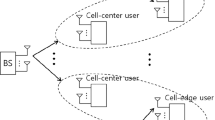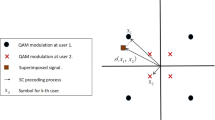Abstract
Serving multiple users in the same resource block in non-orthogonal multiple access (NOMA) induces interference, which limits the achievable rate for each user. In this paper, the problem of maximization of the number of admissible users is solved in the downlink multiple input multiple output (MIMO)-NOMA systems, under a total transmission power constraint and ergodic user-rate constraints. A closed-form lower bound for the achievable ergodic rate is obtained. A power allocation scheme is derived. Three user admission algorithms are proposed to calculate the maximum number of admissible users for three different user ordering strategies. A comparison between the three ordering strategies is conducted, in terms of the maximum number of admissible users and the capability of admitting far users from the base station (BS). In the first and second strategies, users within each cluster are sorted, based on their channel variances, in a descending order, while in the third strategy, users in all the clusters are sorted in a descending order. In the second strategy, the user clusters are similar unlike the first and third strategies. The results show that the proposed algorithms efficiently compute the maximum number of admissible users. The second strategy achieves the greatest number of admissible users, followed by the first strategy, and then the third strategy, which provides the least number of admissible users. Moreover, the second strategy has the least capability of admitting far users, followed by the third strategy, and then the first strategy, which has the greatest capability of admitting far users.



Similar content being viewed by others
Notes
All the circles are concentric about the BS. Equal spacings between the concentric circles imply a constant Δ. Users on the same line are admitted to the same cluster. Users on the same circle are admitted to different clusters and are at the same distance from the BS.
References
Dai L, Wang B, Yuan Y, Han S, Chih-Lin I, Wang Z (2015) Non-orthogonal multiple access for 5G: solutions, challenges, opportunities, and future research trends. IEEE Commun Mag 53(9):74–81
Wu Z, Lu K, Jiang C, Shao X (2018) Comprehensive study and comparison on 5G NOMA schemes. IEEE Access 6:18511–18519
Islam S, Zeng M, Dobre OA (2017) NOMA in 5G systems: exciting possibilities for enhancing spectral efficiency. IEEE 5G Tech. Focus 1(2):1–6
Islam SR, Avazov N, Dobre OA, Kwak KS (2017) Power-domain non-orthogonal multiple access (NOMA) in 5G systems: potentials and challenges. IEEE Commun Surv Tutorials 19(2):721–742
Ding Z, Lei X, Karagiannidis GK, Schober R, Yuan J, Bhargava VK (2017) A survey on non-orthogonal multiple access for 5G networks: research challenges and future trends. IEEE J Sel Areas Commun 35(10):2181–2195
Cover T (1972) Broadcast channels. IEEE Trans Inf Theory 18(1):2–14
Wong VW, Schober R, Ng DWK, Wang LC (2017) Key technologies for 5G wireless systems. Cambridge University Press, Cambridge
Boccardi F, Heath RW, Lozano A, Marzetta TL, Popovski P (2014) Five disruptive technology directions for 5G. IEEE Commun Mag 52(2):74–80
Do TN, da Costa DB, Duong TQ, An B (2018) Improving the performance of cell-edge users in NOMA systems using cooperative relaying. IEEE Trans Commun 66(5):1883–1901
Do TN, da Costa DB, Duong TQ, An B (2018) Improving the performance of cell-edge users in MISO-NOMA systems using TAS and SWIPT-based cooperative transmissions. IEEE Transactions on Green Communications and Networking 2(1):49–62
Ding Z, Fan P, Poor HV (2017) Random beamforming in millimeter-wave NOMA networks. IEEE Access 5:7667–7681
Saito Y, Kishiyama Y, Benjebbour A, Nakamura T, Li A, Higuchi K (2013) Non-orthogonal multiple access (NOMA) for cellular future radio access. In: Proc IEEE inter symposium on vehicular technology conference (VTC spring), pp 1–5
Tse D, Viswanath P (2005) Fundamentals of wireless communication. Cambridge University Press, Cambridge
Liu Y, Pan G, Zhang H, Song M (2016) On the capacity comparison between MIMO-NOMA and MIMO-OMA. IEEE Access 4:2123–2129
Lin H, Gao F, Jin S, Li GY (2017) A new view of multi-user hybrid massive MIMO: non-orthogonal angle division multiple access. IEEE J Sel Areas Commun 35(10):2268–2280
Kim B, Lim S, Kim H, Suh S, Kwun J, Choi S, Lee C, Lee S, Hong D (2013) Non-orthogonal multiple access in a downlink multiuser beamforming system. In: Proc IEEE inter symposium on military communications conference (MILCOM), pp 1278–1283
Shin W, Vaezi M, Lee B, Love DJ, Lee J, Poor HV (2017) Coordinated beamforming for multi-cell MIMO-NOMA. IEEE Commun Lett 21(1):84–87
Amin SH, Mehana AH, Soliman SS, Fahmy YA (2018) Power allocation for maximum MIMO-NOMA system user-rate. In: Proc IEEE inter Workshop on non-orthogonal multiple access techniques for 5G (NOMA5G), pp 1–6
Ding Z, Schober R, Poor HV (2016) A general MIMO framework for NOMA downlink and uplink transmission based on signal alignment. IEEE Trans Wirel Commun 15(6):4438–4454
Ding Z, Schober R, Poor HV (2016) On the design of MIMO-NOMA downlink and uplink transmission. In: Proc IEEE inter conference on communications (ICC), pp 1–6
Zeng M, Yadav A, Dobre OA, Tsiropoulos GI, Poor HV (2017) On the sum rate of MIMO-NOMA and MIMO-OMA systems. IEEE Wireless Commun Lett 6(4):534–537
Al-Abbasi ZQ, So DK, Tang J (2017) Resource allocation for MU-MIMO non-orthogonal multiple access (NOMA) system with interference alignment. In: Proc IEEE inter conference on communications (ICC), pp 1–6
Shin W, Vaezi M, Lee J, Poor HV (2016) On the number of users served in MIMO-NOMA cellular networks. In: Proc IEEE inter symposium on wireless communication systems (ISWCS), pp 638–642
Hanif MF, Ding Z, Ratnarajah T, Karagiannidis GK (2016) A minorization-maximization method for optimizing sum rate in the downlink of non-orthogonal multiple access systems. IEEE Trans Signal Process 64 (1):76–88
Chen X, Zhang Z, Zhong C, Ng DWK (2017) Exploiting multiple-antenna techniques for non-orthogonal multiple access. IEEE J Sel Areas Commun 35(10):2207–2220
Chen C, Cai W, Cheng X, Yang L, Jin Y (2017) Low complexity beamforming and user selection schemes for 5G MIMO-NOMA systems. IEEE J Sel Areas Commun 35(12):2708–2722
Sun Q, Han S, Chin-Lin I, Pan Z (2015) On the ergodic capacity of MIMO NOMA systems. IEEE Wireless Commun Lett 4(4):405–408
Ding Z, Dai L, Poor HV (2016) MIMO-NOMA design for small packet transmission in the internet of things. IEEE Access 4:1393–1405
Sun Q, Han S, Xu Z, Wang S, Chih-Lin I, Pan Z (2015) Sum rate optimization for MIMO non-orthogonal multiple access systems. In: Proc IEEE inter Wireless communications and networking conference (WCNC), pp 747–752
Yang Z, Xu W, Pan C, Pan Y, Chen M (2017) On the optimality of power allocation for NOMA downlinks with individual QoS constraints. IEEE Commun Lett 21(7):1649–1652
Nguyen VD, Tuan HD, Duong TQ, Poor HV, Shin OS (2017) Precoder design for signal superposition in MIMO-NOMA multicell networks. IEEE J Sel Areas Commun 35(12):2681–2695
Han S, Chih-Lin I, Xu Z, Sun Q (2014) Energy efficiency and spectrum efficiency co-design: from NOMA to network NOMA. IEEE COMSOC MMTC E-Letter 9(5):21–24
Sun Q, Han S, Chin-Lin I, Pan Z (2015) Energy efficiency optimization for fading MIMO non-orthogonal multiple access systems. In: Proc IEEE inter Conference on communications (ICC), pp 2668–2673
Nguyen LD (2018) Resource allocation for energy efficiency in 5G wireless networks EAI Endorsed Transactions on Industrial Networks and Intelligent Systems 5(14). https://doi.org/10.4108/eai.27-6-2018.154832
Zeng M, Yadav A, Dobre OA, Tsiropoulos GI, Poor HV (2017) Capacity comparison between MIMO-NOMA and MIMO-OMA with multiple users in a cluster. IEEE J Sel Areas Commun 35(10):2413–2424
Amin SH, Mehana AH, Soliman SS, Fahmy YA (2018) User capacity in downlink MISO-NOMA systems. In: Proc IEEE inter. Global communications conference (GLOBECOM), pp 1–6
Ngo HQ, Larsson EG, Marzetta TL (2013) Energy and spectral efficiency of very large multiuser MIMO systems. IEEE Trans Commun 61(4):1436–1449
Author information
Authors and Affiliations
Corresponding author
Rights and permissions
About this article
Cite this article
Amin, S.H., Mehana, A.H., Fahmy, Y.A. et al. Maximizing the Number of Users in Clustered MIMO-NOMA Systems Under Rate Constraints. Mobile Netw Appl 24, 618–629 (2019). https://doi.org/10.1007/s11036-018-1162-4
Published:
Issue Date:
DOI: https://doi.org/10.1007/s11036-018-1162-4




